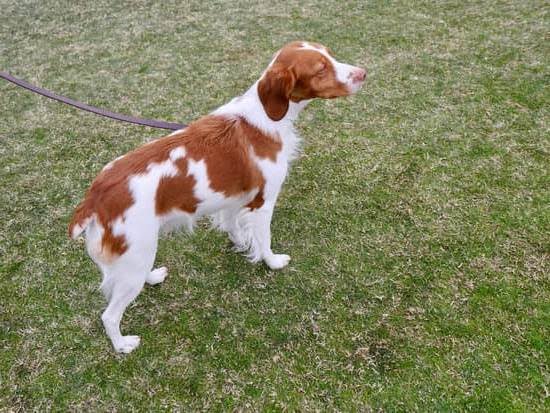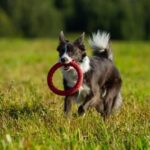Introduction
Dogs that suffer from extreme anxiety can present a unique challenge to their owners. Unlike dogs who are typically happy and confident, anxious dogs may react negatively to stimuli and unfamiliar environments, displaying signs such as trembling, barking or cowering in fear. Exacerbating an already difficult situation is the fact that in many cases the cause of their anxiety is unknown. It can be quite disheartening for their owners to attempt to console them while they struggle with emotions they do not understand.
Fortunately, there are steps that can be taken by any owner of an anxious dog no matter how severe the animal’s symptoms may be. With patience and care, owners can train their canine companions to become more comfortable in certain situations over time. The following guide provides advice on how best to train an extremely anxious dog using desensitization exercises as well as other methods for making progress towards overcoming behaviors associated with stress and fear.
One of the most important components of developing a bonding relationship with an anxious pup is understanding what triggers their irrational responses in specific situations. It is necessary for owners first to observe the behavior when faced with the environment precipitating it whether it be another person, a sound or a certain location or activity. Possessing knowledge of these triggers allows participants to work together on reducing or eliminating its influence so that comfort levels eventually increase and both pet and master form a positive association going forward into future encounters.
Once triggers have been identified, it is possible then to begin employing desensitization exercises as well as counterconditioning programs which introduce distracting rewards concurrently during exposure exercises presented in stages starting at highly manageable levels then increasing gradually over time until objectives have been reached without causing further distress than nothing had been accomplished beforehand at all . Additionally dietary therapists also recommend particular food sources rich in calming properties such as certain proteins and supplements designed specifically for pets prone toward heightened anxiety such as fish oils and natural calming aids like chamomile herbs – all accessible via online nutritional outlets or through your local veterinarian’s office.
Types of Anxiety in Dogs
There are several types of anxiety that can affect dogs, such as separation anxiety, new environment anxiety, noise phobias, and more. It is important to determine which type your dog is experiencing before attempting to train them.
Separation Anxiety: An extremely anxious reaction to being left alone is usually a sign of Separation Anxiety. Dogs may bark or howl continually when left alone, or have destructive behaviors such as furniture chewing or digging in the yard. These behaviors are the dog’s attempt to cope with the feeling of being away from their owners for too long. Separation Anxiety can be treated by gradually introducing the dog to short periods unaccompanied by its owner. Reward good behavior and discourage bad behavior with positive reinforcement and ignore negative reactions when you return home.
New Environment Anxiety: If your dog shows fear or aggression towards unfamiliar places and people, it may be suffering from New Environment Anxiety. This often occurs due to lack of suitable training as a puppy, but can be addressed with consistency and patience on behalf of the owner. Take walks around familiar areas with lots of positive reinforcement when your dog meets people or goes to new places until they gain trust in those situations. Gradually increase the amount of new environments encountered so that eventually the dog will feel comfortable in those settings without any fear.
Noise Phobias: Dogs who experience extreme distress over loud noises like fireworks or construction may suffer from Noise Phobias. To tackle this type of anxiety it’s important to allow your pup some form of distraction before each loud noise occurs (like giving them a toy). Creating an escape route such as hiding under blankets or providing them with a comfortable kennel can help them feel safe during these events. Depending on their individual responses you may need to provide additional comfort; consulting a vet or animal behavioral specialist can reveal further methods for treating canine noise phobia issues effectively and safely.
Setting up the Ideal Training Environment
Creating an ideal training environment for extremely anxious dogs is essential to their successful rehabilitation. This means finding a calm and safe place that ensures your pet is not exposed to any additional stimuli or sources of stress.
A good approach when selecting a location is to try and limit the number of triggers that can increase your dog’s anxiety levels, while still allowing them access to the area and activities they need. To do this, you might want to find somewhere quiet with little noise, no easily-distributable distractions such as other people or animals, and plenty of wide open spaces where your dog can feel safe. Additionally, if possible you should avoid busy streets or pathways in order to ensure that sudden disturbances don’t cause distress for your pet.
Once you decide on the environment for training, it is important to create routines and boundaries that make your dog feel secure. This entails ensuring that all commands are consistent, encouraging them when they obey rules, and setting strict limits so they know what behaviors are and aren’t acceptable. Providing treats after certain exercises will help motivate them and further reinforce the lesson being taught. Finally, purposefully ending each session before your pet becomes overwhelmed helps keep their stress levels from escalating beyond acceptable levels.
Establishing an Effective Rewards-Based Training Program
When dealing with an extremely anxious dog, it is essential to create a reward-based training program that the animal can understand clearly and respond positively to. The rewards should be something that the dog finds reinforcing and enjoyable, such as treats or verbal praise. You will need to involve the entire family in providing rewards, so everyone should know what types of rewards are appropriate and incentivizing for the dog.
Once the rewards system has been established, you can begin teaching your dog basic commands. Start by introducing simple verbal commands such as “sit”, “stay”, “come”, etc., and use high motivation treats when introducing these commands to ensure your dog responds positively. Whenever your dog successfully follows a command, give them a reward immediately after. This teaches them that good behavior will lead to desirable rewards, which helps create stronger associations between your instructions and positive behavior from your pet. Additionally, you can reduce anxiety in anxious dogs by building trust through small amounts of exposure over short periods of time – for example taking short walks around the block rather than long hikes in open fields.
It is important to pay attention not just to successes but also of mistakes during training sessions – if a mistake is made you should console your pet with comfort rather than punishment while explaining why they made that error in language they can understand. This ensures associating failure with a secure environment, which helps reduce anxiety levels in overly anxious dogs significantly. To ensure successful training overall it is worth considering hiring an experienced canine behavioral specialist or trainer who can help provide expert guidance on how best to approach training sessions while keeping both yourself and your pup safe and secure throughout the process!
Building Dogs’ Self-Esteem Through Training
When training an extremely anxious dog, it is important to focus on building the animal’s self-esteem. This can be done through positive reinforcement methods such as praise and treats when behaviors are successful. As the dog learns new skills and experiences less anxious behaviors, they will gain more confidence in themselves and their abilities. Developing a strong bond between the owner and their pet is also key; longer playtimes, regular grooming, cuddle time – all of these activities go a long way in helping dogs feel safer and comfortable around people while reinforcing the connection they share with their owner. Another way to help reduce anxiety levels is by gradually introducing the dog to new people or animals that you think may cause fear or apprehension at first. Exposing them to these stimuli bit by bit will allow them to become accustomed to them over time with fewer chances of experiencing high stress levels or panic attacks when meeting something unfamiliar. Lastly, giving your pup breaks from intensive training sessions is paramount; shorter but more frequent times spent learning new commands lessens their stress levels and builds a sense of trust with you since they know what you ask from them won’t just take over their day every day.
Incorporating Consistent Training Techniques
Training an extremely anxious dog requires patience and consistency. Many extreme cases of anxiety in dogs can be attributed to lack of exposure or perceived danger in the environment for the dog. Prior to beginning any kind of behavior modification regimen it is important to have a thorough assessment by a qualified professional, such as a veterinarian or certified animal behaviorist. Once an appropriate plan has been created, consistent training techniques should be used when working with an anxious dog. These techniques may include counterconditioning and desensitization, socializing the pup in controlled settings, and providing plenty of positive reinforcement when the pup remains calm and makes progress towards goals.
Counterconditioning is a technique used to change a negative feeling into one that is more positive. This could involve helping your dog become comfortable around people or other animals after initially being fearful in their presence. When first introducing them to people, it is best to keep interactions short and meaningful while ensuring they are enjoyable experiences for your pup. If they remain fearful these experiences should be ended right away so further anxiety can be avoided.
Desensitization is another training tactic that can help reduce fear responses in anxious dogs. This process involves gradually exposing the pup to whatever causes their anxiety (e.g., loud noises) at low levels until their response begins improving and then gradually increasing the intensity of those exposures until their negative feelings start subsiding or disappear altogether. It’s important with this technique to start small and always keep safety as the number one priority for both you and your pup throughout this process.
Finally, positive reinforcement plays a major role in successfully modifying behaviors from anxious ones into calmer states of being through reward-based training methods such as clicker-training, treat-rewards, verbal praise and/or physical affection. Approximately 80% of all reinforcements you give during training sessions should be positive rewards like these rather than corrections or negative markers that may contribute further anxiety to an already high-stressed state of mind in some dogs.
Keeping Training Sessions Pleasant and Enjoyable
It is important to make training sessions enjoyable, short and positive when working with an extremely anxious dog. Start off the training by rewarding even tiny successes with treats and positive words or attention. Make sure that you are speaking in a calm and relaxed voice during the session; anxious dogs will pick up on any negative energy in the environment, so it’s important to remain positive. These sessions should not be too long, as they may become overwhelming for your pup. Move around in different areas of the house or outside (if it’s safe) in order to keep things interesting and avoid making your pup feel like their stuck in one spot for too long. Change up commands throughout the session as well to keep their focus on the task at hand. After each successful interaction end on a high note – continue showing them lots of praise and treats! Doing this consistently will help build your pup’s confidence and trust in you which is essential for future success.
Recognizing and Working Through Setbacks
Dogs, like people, can become overwhelmed when exposed to unfamiliar situations or environments. Similarly, a vast majority of dogs discharged from military or police service exhibit hyper-arousal and anxious behaviors following their time in active duty. However, with the right training methods and instructor, the behavior of these dogs can be effectively conditioned.
When attempting to work through extreme anxiety in dogs it is important for their trainers to be aware that there may be setbacks. Whenever an anxious dog simply refuses to move forward with normal training methods, a coach should first use relaxation techniques such as slowly petting them until they are calm enough to proceed. It is also important to control environmental pressures by keeping noisy distractions away such as loud noises, bright lights and other stimuli which can agitate the dog even further.
When a major setback occurs while working with an extremely anxious dog it is necessary for trainers to modify the program accordingly based on their assessment of the animal’s needs. A more gradual approach should be taken since drastic changes may cause uncomfortable levels of stress which results in regressions rather than progressions in behavior modification techniques. If stressors continue causing regression then reevaluation of the training regimen should occur; avoiding large jumps into new tasks by returning a few stages back and increasing difficulty gradually until desired goals have been achieved.
Modifying Strategies as Needed
One way to train an extremely anxious dog is to take things slow. Start out with simple commands such as sit, stay and down. Do not rush your dog through the training process; if it is not responding correctly, back up several steps and start again.
Another strategy for training an extremely anxious dog is to focus on positive reinforcement rather than punishing mistakes. Praise your pup when it does something correctly or even when it takes a step in the right direction. It may also be beneficial to give treats as a reward during this time. Additionally, do not start with any type of harsh commands or discipline like scolding or shouting. This can actually increase their anxiety levels and make the situation much worse.
When dealing with an extremely anxious dog, it is important to modify strategies accordingly to best suit its needs. Some dogs require more patience and individualized strategies than others might need. Additionally, that same strategy will likely not work for every episode of anxiety they may have in different situations; so you must be prepared to adjust your approach as needed depending on the context and level of worry your pup may be exhibiting at any given time. Lastly, always practice kindness by using positive language and providing ample reinforcement once behaviors have been corrected or adequately managed. This will help create a sense of trust between you both which is essential for successful training sessions long-term.
Conclusion
Creating a successful training routine for an extremely anxious dog requires patience and dedication. Start by building a bond with your pet, which involves lavishing them with acceptance and praise. Treats can help reinforce positive behavior, though it should be used sparingly for dogs with anxiety. A consistent routine is also important in order to create an environment of safety where your pup can learn new things without getting overwhelmed. Exercise and play sessions are also key components of calming anxious dogs down and giving them the mental stimulation they need. Lastly, it’s important to set clear boundaries in order to provide structure and keep your pup’s anxiety levels under control. With all of these elements put together, you will be able to create a successful training routine that will help reduce stress and worry in your beloved pet.

Welcome to the blog! I am a professional dog trainer and have been working with dogs for many years. In this blog, I will be discussing various topics related to dog training, including tips, tricks, and advice. I hope you find this information helpful and informative. Thanks for reading!





